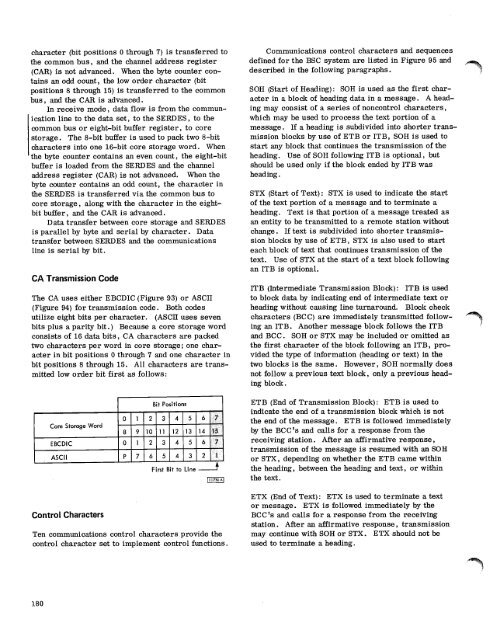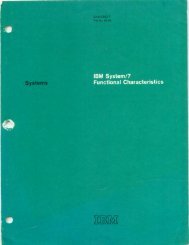Systems Reference Library - All about the IBM 1130 Computing ...
Systems Reference Library - All about the IBM 1130 Computing ...
Systems Reference Library - All about the IBM 1130 Computing ...
- No tags were found...
You also want an ePaper? Increase the reach of your titles
YUMPU automatically turns print PDFs into web optimized ePapers that Google loves.
character (bit positions 0 through 7) is transferred to<strong>the</strong> common bus, and <strong>the</strong> channel address register(CAR) is not advanced. When <strong>the</strong> byte counter containsan odd count, <strong>the</strong> low order character (bitpositions 8 through 15) is transferred to <strong>the</strong> commonbus, and <strong>the</strong> CAR is advanced.In receive mode, data flow is from <strong>the</strong> communicationline to <strong>the</strong> data set, to <strong>the</strong> SERDES, to <strong>the</strong>common bus or eight-bit buffer register, to corestorage. The 8-bit buffer is used to pack two 8-bitcharacters into one 16-bit core storage word. When<strong>the</strong> byte counter contains an even count, <strong>the</strong> eight-bitbuffer is loaded from <strong>the</strong> SERDES and <strong>the</strong> channeladdress register (CAR) is not advanced. When <strong>the</strong>byte counter contains an odd count, <strong>the</strong> character in<strong>the</strong> SERDES is transferred via <strong>the</strong> common bus tocore storage , along with <strong>the</strong> character in <strong>the</strong> eightbitbuffer, and <strong>the</strong> CAR is advanced.Data transfer between core storage and SERDESis parallel by byte and serial by character. Datatransfer between SERDES and <strong>the</strong> communicationsline is serial by bit.CA Transmission CodeThe CA uses ei<strong>the</strong>r EBCDIC (Figure 93) or ASCII(Figure 94) for transmission code. Both codesutilize eight bits per character. (ASCII uses sevenbits plus a parity bit.) Because a core storage wordconsists of 16 data bits, CA characters are packedtwo characters per word in core storage; one characterin bit positions 0 through 7 and one character inbit positions 8 through 15. <strong>All</strong> characters are transmittedlow order bit first as follows:Core Storage WordBit Positions0 1 2 3 4 5 68 9 10 11 12 13 14 15EBCDIC 0 1 2 3 4 5 6 7ASCII P 7 6 5 4 3First Bit to Line111730A1Communications control characters and sequencesdefined for <strong>the</strong> BSC system are listed in Figure 95 anddescribed in <strong>the</strong> following paragraphs.SOH (Start of Heading): SOH is used as <strong>the</strong> first characterin a block of heading data in a message. A headingmay consist of a series of noncontrol characters,which may be used to process <strong>the</strong> text portion of amessage. If a heading is subdivided into shorter transmissionblocks by use of ETB or ITB, SOH is used tostart any block that continues <strong>the</strong> transmission of <strong>the</strong>heading. Use of SOH following ITB is optional, butshould be used only if <strong>the</strong> block ended by ITB washeading.STX (Start of Text): STX is used to indicate <strong>the</strong> startof <strong>the</strong> text portion of a message and to terminate aheading. Text is that portion of a message treated asan entity to be transmitted to a remote station withoutchange. If text is subdivided into shorter transmissionblocks by use of ETB, STX is also used to starteach block of text that continues transmission of <strong>the</strong>text. Use of STX at <strong>the</strong> start of a text block followingan ITB is optional.ITB (Intermediate Transmission Block): ITB is usedto block data by indicating end of intermediate text orheading without causing line turnaround. Block checkcharacters (BCC) are immediately transmitted followingan ITB. Ano<strong>the</strong>r message block follows <strong>the</strong> ITBand BCC. SOH or STX may be included or omitted as<strong>the</strong> first character of <strong>the</strong> block following an ITB, provided<strong>the</strong> type of information (heading or text) in <strong>the</strong>two blocks is <strong>the</strong> same. However, SOH normally doesnot follow a previous text block, only a previous headingblock.ETB (End of Transmission Block): ETB is used toindicate <strong>the</strong> end of a transmission block which is not<strong>the</strong> end of <strong>the</strong> message. ETB is followed immediatelyby <strong>the</strong> BCC's and calls for a response from <strong>the</strong>receiving station. After an affirmative response,transmission of <strong>the</strong> message is resumed with an SOHor STX, depending on whe<strong>the</strong>r <strong>the</strong> ETB came within<strong>the</strong> heading, between <strong>the</strong> heading and text, or within<strong>the</strong> text.Control CharactersTen communications control characters provide <strong>the</strong>control character set to implement control functions.ETX (End of Text): ETX is used to terminate a textor message. ETX is followed immediately by <strong>the</strong>BCC's and calls for a response from <strong>the</strong> receivingstation. After an affirmative response, transmissionmay continue with SOH or STX. ETX should not beused to terminate a heading.180
















